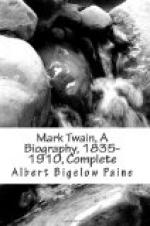In the Christmas Harper for 1904 was published “Saint Joan of Arc”—the same being the Joan introduction prepared in London five years before. Joan’s proposed beatification had stirred a new interest in the martyred girl, and this most beautiful article became a sort of key-note of the public heart. Those who read it were likely to go back and read the Recollections, and a new appreciation grew for that masterpiece. In his later and wider acceptance by his own land, and by the world at large, the book came to be regarded with a fresh understanding. Letters came from scores of readers, as if it were a newly issued volume. A distinguished educator wrote:
I would rather have written
your history of Joan of Arc than any
other piece of literature
in any language.
And this sentiment grew. The demand for the book increased, and has continued to increase, steadily and rapidly. In the long and last analysis the good must prevail. A day will come when there will be as many readers of Joan as of any other of Mark Twain’s works.
[The growing appreciation of Joan is shown by the report of sales for the three years following 1904. The sales for that year in America were 1,726; for 1905, 2,445 for 1906, 5,381; for 1907, 6,574. At this point it passed Pudd’nhead Wilson, the Yankee, The Gilded Age, Life on the Mississippi, overtook the Tramp Abroad, and more than doubled The American Claimant. Only The Innocents Abroad, Huckleberry Finn, Tom Sawyer, and Roughing It still ranged ahead of it, in the order named.]
CCXXXIV
LIFE AT 21 FIFTH AVENUE
The house at 21 Fifth Avenue, built by the architect who had designed Grace Church, had a distinctly ecclesiastical suggestion about its windows, and was of fine and stately proportions within. It was a proper residence for a venerable author and a sage, and with the handsome Hartford furnishings distributed through it, made a distinctly suitable setting for Mark Twain. But it was lonely for him. It lacked soul. He added, presently, a great AEolian Orchestrelle, with a variety of music for his different moods. He believed that he would play it himself when he needed the comfort of harmony, and that Jean, who had not received musical training, or his secretary could also play to him. He had a passion for music, or at least for melody and stately rhythmic measures, though his ear was not attuned to what are termed the more classical compositions. For Wagner, for instance, he cared little, though in a letter to Mrs. Crane he said:
Certainly nothing in the world is so solemn and impressive and so divinely beautiful as “Tannhauser.” It ought to be used as a religious service.
Beethoven’s sonatas and symphonies also moved him deeply. Once, writing to Jean, he asked:
What is your favorite piece of music, dear? Mine is Beethoven’s Fifth Symphony. I have found that out within a day or two.




